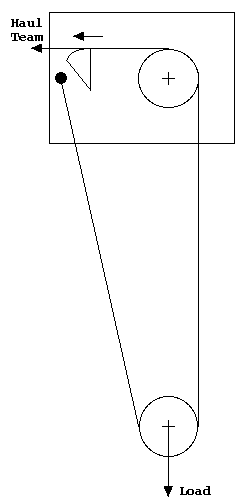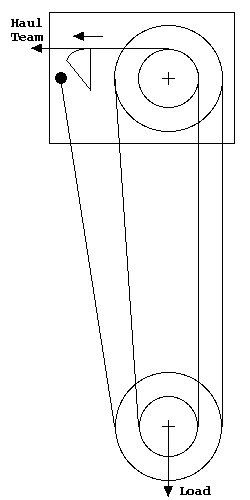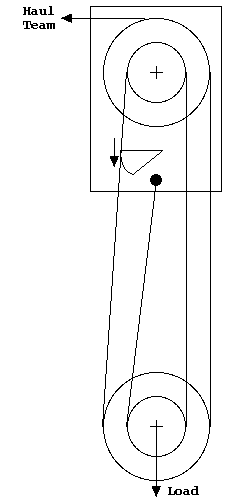Overview
History
Boris Rogelja founded Single Rope Technique Equipment (SRTE) in 1980. Capital Safety Group acquired SRTE in 2011 and their devices started showing DBI-SALA, Capital Safety, and/or Rollgliss™ markings. Some of these continued to show SRTE markings, and some did not. There does not appear to be a specific date when the markings disappeared. Different devices removed the SRTE logo at different times. 3M acquired the Capital Safety Group in 2015 and the Single Rope Technique Equipment markings disappeared completely.
[ Top
| RM22
| Return to Hauling Pulleys
]
RM2 Rescuemate
(#3756)
Technical Details
 I acquired my SRT RM2 Rescuemate from Inner Mountain Outfitters
in 1994. The SRT RM2 Rescuemate is 254 mm. tall, 80 mm
wide, and 40 mm. thick. Mine weighs 69 g.
I acquired my SRT RM2 Rescuemate from Inner Mountain Outfitters
in 1994. The SRT RM2 Rescuemate is 254 mm. tall, 80 mm
wide, and 40 mm. thick. Mine weighs 69 g.
The Single Rope Technique Equipment RM22 Rescuemate is a single pulley
with an eccentric cam that prevents one strand of rope from entering
the device. The
unfinished aluminum pulley is 48 mm. in diameter. The central frame is an anodized aluminum extrusion
with a rectangular channel for mounting the cam and an 18 mm. U-shaped
channel for the rope. The cam has a hold-open safety mounted on
the lower tip of the cam. The cam is riveted to the frame, so
it cannot easily be replaced when worn. It is a pity that this
wasn't bolted on. A 3 mm. cord is tied to the cam so the cam can
be opened remotely. On the back of the frame there is a cord lock
mounted with an Allen-head cap screw. There is a rope guiding
post complete with a nonfunctional groove; however, this part
is also used on the SRT
stop bobbins, so this is just a case of using a pre-existing
part. There is a carabiner hole at the bottom of the device.
No directions were provided with the device. There is an obvious
way to rig the device for a 2:1 hauling system where the cam supports
one half of the load, but the frame pivots with each pull and
the rope runs over a portion of the rope channel that should have
been rounded, but wasn't. Thirty seconds with a rat-tail file
will fix this oversight.
I think that
the pulley is too small since it allows the rope to drag on the
back of the cam channel under certain situations. The pulley can
handle ropes up to 13 or 14 mm. without dragging, and up to 18
or 20 mm. with degraded performance. The pulley side plate is anodized.
The pulley and side plate are riveted to the frame. The pulleys
and side plate are rather tight, and the pulley does not turn
as freely as one might wish.
Overall, this is a well-made device designed for rescue applications.
I would recommend choosing the RM22 instead, since the extra pulley
there allows rigging a 4:1 system if desired. Any mechanical advantage
system has certain dangers, so it is important that the team not
overstress any components. When rigged correctly, it is unlikely
that this device will be the weakest link.
[ Top
| RM2
| Return to Hauling Pulleys
]
RM22 Rescuemate
(#3757, 2658)
Technical Details
 I acquired my SRT RM22 Rescuemate from Inner Mountain Outfitters
in 1994. I acquired another in 2017 as part of Bob Thrun’s collection.
I acquired my SRT RM22 Rescuemate from Inner Mountain Outfitters
in 1994. I acquired another in 2017 as part of Bob Thrun’s collection.
The SRT RM22 Rescuemate is 254 mm. tall, 80 mm
wide, and 63 mm. thick. Mine weighs 902 g.
 The SRT RM22 Rescuemate is a double pulley with an eccentric
cam that prevents one strand of rope from entering the device. The two unfinished aluminum pulleys are 48 mm. in diameter. The central frame is an anodized aluminum extrusion with a rectangular
channel for mounting the cam and an 18 mm. U-shaped channel for
the rope. The cam has a hold-open safety mounted on the lower
tip of the cam. The cam is riveted to the frame, so it cannot
easily be replaced when worn. It is a pity that this wasn't bolted
on. A 3 mm. cord is tied to the cam so the cam can be opened remotely.
On the back of the frame there is a cord lock mounted with an
Allen-head cap screw. There is a rope guiding post complete with
a nonfunctional groove; however, this part is also used on the SRT stop bobbins,
so this is just a case of using a pre-existing part. There is
a carabiner hole at the bottom of the device.
The SRT RM22 Rescuemate is a double pulley with an eccentric
cam that prevents one strand of rope from entering the device. The two unfinished aluminum pulleys are 48 mm. in diameter. The central frame is an anodized aluminum extrusion with a rectangular
channel for mounting the cam and an 18 mm. U-shaped channel for
the rope. The cam has a hold-open safety mounted on the lower
tip of the cam. The cam is riveted to the frame, so it cannot
easily be replaced when worn. It is a pity that this wasn't bolted
on. A 3 mm. cord is tied to the cam so the cam can be opened remotely.
On the back of the frame there is a cord lock mounted with an
Allen-head cap screw. There is a rope guiding post complete with
a nonfunctional groove; however, this part is also used on the SRT stop bobbins,
so this is just a case of using a pre-existing part. There is
a carabiner hole at the bottom of the device.
No directions
came with the device. There are two obvious ways to rig
the device for a 4:1 hauling system. In the first, the cam supports
one third of the load while the hauling team resets for another
pull. In the second, the cam supports one fourth of the load,
but the frame pivots with each pull and the rope runs over a portion
of the rope channel that should have been rounded, but wasn't.
Thirty seconds with a rat-tail file will fix this oversight.
I think that the front pulley is too small since it allows the
rope to drag on the back of the cam channel under certain situations.
The pulleys can handle ropes up to 13 or 14 mm. without dragging,
and up to 18 or 20 mm. with degraded performance. The pulley side
plates are anodized. The pulleys and side plates are riveted to
the frame. The pulleys and side plates are rather tight, and the
pulleys do not turn as freely as one might wish.
Overall, this is a well-made device designed for rescue applications.
Any mechanical advantage system has certain dangers, so it is
important that the team not overstress any components. When rigged
correctly, it is unlikely that this device will be the weakest
link.
[ Top
| RM2
| RM22
]


